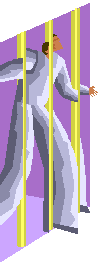
How the Heck Does that Laser Figure In?

In deeper clarification of how the laser focuses the data, it is important to note that a considerable amount of computer technology is utilized.³ “The fundamental job of the CD player is to focus the laser on the track of bumps.”³ “The laser beam passes through the polycarbonate layer, reflects off the aluminum layer and hits an opto-electronic device that detects changes in light.”³ The projections of the bumps are picked up and “reflected differently” than the areas on the CD that are not upraised; these differences are recognized by the opto-electric sensor, and the processes that detect the reflections “read the bits that make up the bytes” to decipher the data.³
How does Tracking Figure in?

The tracking system’s main responsibility in the CD player is to focus and center the laser beam on the long track data. As the music plays on the CD, the system shifts the beam further and further outward from the innermost area of the CD, passing by the bumps at higher speeds.³ “The bumps move past the laser faster . . . because the linear . . . speed of the bumps is equal to the radius times the speed at which the disc is revolving (rpm).”³ The revolving speed of the CD is slowed by the spindle motor, to that “the bumps travel past the laser at a constant speed, and the data comes off the [CD] at a constant rate.”^4
Storing and encoding data on a CD is a very intricate endeavor; therefore, several factors must be taken into account and dealt with. The CD projections, or bumps, are used to target the laser to follow their pattern, but the gaps between projections on the data track must be minimal.^4 So, “data is encoded using EFM (eight-fourteen modulation) . . . where 8-bit bytes are converted to 14 bits, and it is guaranteed by EFM that some of those bits will be 1s.”^4 Due to the fact that there are separate songs comprising a CD, the data must communicate the location of the music so that the laser is able to detect it on the disc.^4 “Subcode data can encode the absolute and relative position of the laser in the track, and can also encode such things as song titles.”^4 To avoid the chance of the laser beam misreading a projection off of the disc, error-correcting codes are encoded as well, to compensate for detection errors.^4
Then, there is also the problem of a CD getting scratched or damaged in some way, so that the possibility of a significant amount of bytes may be misread by the laser. Interleaving data solves this dilemma by storing the CD data “non-sequentially around one of its circuits.”^4 This lets the system read the data “one revolution at a time, and un-interleaves the data in order to play it.” ^4
Sources
*³. http://www.howstuffworks.com/cd.htm/printable. PAGE 3.
*^4. http://www.howstuffworks.com/cd.htm/printable. Page 4.
"This page is not that of a real company but is for a chemistry assignment for General Chemistry 140 at Monmouth College."